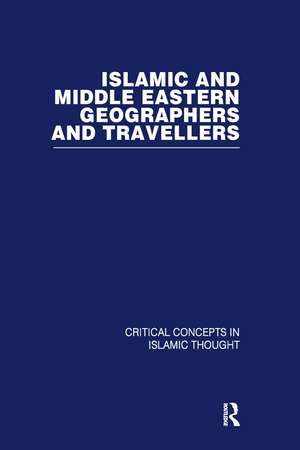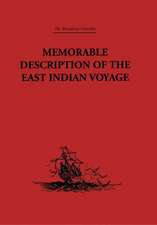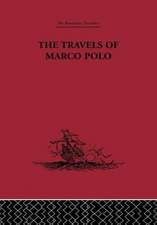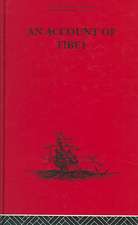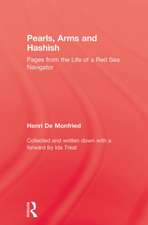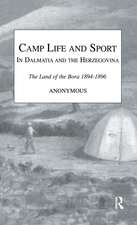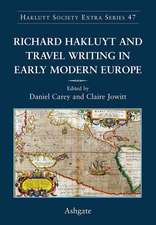Islamic and Middle Eastern Travellers and Geographers: Critical Concepts in Islamic Studies
Editat de Ian Nettonen Limba Engleză Hardback – 21 dec 2007
The first volume concentrates on the Islamic geographers who mapped and made navigable the routes followed by later travellers. While travel, and in particular the rihla (or ‘travel to Mecca’) did not depend for its impetus on formal geography, both were highlighted in the travellers’ diaries and travelogues which helped to make known and illuminate the boundaries of an expanding empire. Links between geography and the pilgrim routes to Mecca and Medina are particularly significant.
Because of their huge significance in illuminating the medieval world of Islam, a very large number if articles deal with the travels of Ibn Jubayr (1145–1217) (Volume II) and Ibn Battuta (1304–368/9 or 1377) (Volume III), while Volume IV covers the post-medieval and early modern period.
Din seria Critical Concepts in Islamic Studies
- 34%
 Preț: 4239.15 lei
Preț: 4239.15 lei - 34%
 Preț: 6741.77 lei
Preț: 6741.77 lei - 33%
 Preț: 1279.94 lei
Preț: 1279.94 lei - 34%
 Preț: 6189.19 lei
Preț: 6189.19 lei - 34%
 Preț: 4924.98 lei
Preț: 4924.98 lei - 36%
 Preț: 4378.50 lei
Preț: 4378.50 lei - 34%
 Preț: 6183.03 lei
Preț: 6183.03 lei - 34%
 Preț: 3961.32 lei
Preț: 3961.32 lei - 34%
 Preț: 5486.58 lei
Preț: 5486.58 lei - 34%
 Preț: 6188.11 lei
Preț: 6188.11 lei - 34%
 Preț: 6191.18 lei
Preț: 6191.18 lei - 34%
 Preț: 4233.57 lei
Preț: 4233.57 lei - 33%
 Preț: 3697.55 lei
Preț: 3697.55 lei - 34%
 Preț: 6186.14 lei
Preț: 6186.14 lei - 34%
 Preț: 6739.46 lei
Preț: 6739.46 lei - 34%
 Preț: 6173.50 lei
Preț: 6173.50 lei - 34%
 Preț: 7295.07 lei
Preț: 7295.07 lei
Preț: 5482.50 lei
Preț vechi: 8301.04 lei
-34% Nou
Puncte Express: 8224
Preț estimativ în valută:
1049.22€ • 1091.34$ • 866.18£
1049.22€ • 1091.34$ • 866.18£
Carte tipărită la comandă
Livrare economică 14-28 aprilie
Preluare comenzi: 021 569.72.76
Specificații
ISBN-13: 9780415351898
ISBN-10: 0415351898
Pagini: 1520
Dimensiuni: 156 x 234 x 102 mm
Greutate: 2.79 kg
Ediția:New.
Editura: Taylor & Francis
Colecția Routledge
Seria Critical Concepts in Islamic Studies
Locul publicării:Oxford, United Kingdom
ISBN-10: 0415351898
Pagini: 1520
Dimensiuni: 156 x 234 x 102 mm
Greutate: 2.79 kg
Ediția:New.
Editura: Taylor & Francis
Colecția Routledge
Seria Critical Concepts in Islamic Studies
Locul publicării:Oxford, United Kingdom
Public țintă
Postgraduate and ProfessionalCuprins
Volume I: Medieval Geographers and Travellers
1. X. De Planhol, ‘The Geographical Setting’, in P. M. Holt, Anne K. S. Lambton, and Bernard Lewis (eds.), The Cambridge History of Islam, Vol. 2 (Cambridge University Press, 1970), pp. 443–68
2. S. Maqbul Ahmad and Fr. Taeschner, ‘Djughrafiya’, in Encyclopaedia of Islam, 2nd edn., Vol. 2 (Leiden: E. J. Brill/London: Luzac, 1965), pp. 575–90
3. Salah Salim Ali, ‘Arabic Reference to Plato’s Lost Atlantis’, Islamic Quarterly, Vol. 43: 4 (1999), pp. 259–78
4. David W. Tschanz, ‘Journeys of Faith, Roads of Civilization’, Saudi Aromco World, Vol. 55: 1 (Jan.–Feb. 2004), pp. 2–11
5. V. Minorsky, ‘Tamín ibn Bahr’s Journey to the Uighurs’, Bulletin of the School of Oriental and African Studies, no. XII (1948), pp. 275–305
6. James E. Montgomery, ‘Ibn Rusta’s Lack of "Eloquence" the Rús, and Samanid Cosmography’, Edebiyat, Vol. 12: 1 (2001), pp. 73–93
7. Judith Gabriel, ‘Among the Norse Tribes: The Remarkable Account of Ibn Fadlan’, Aramco World, Vol. 50: 6 (Nov.–Dec. 1999), pp. 36–42
8. Maria Kowalska, ‘Ibn Fadlan’s Account of His Journey to the State of the Bulgars’, Folia Orientalia, Vol. 14 (1972–3), pp. 219–30
9. James E. Montgomery, ‘Ibn Fadlan and the Rusiyyah’, Journal of Arabic and Islamic Studies, Vol. 3 (2000), pp 1–25
10. Robert P. Blake and Richard N. Frye, ‘Noted on the Risala of Ibn Fadlan’, Byzantina Metabyzantina, Vol. 1: 2 (1949), pp. 7–37
11. James V. Parry, ‘Mapping Arabia’, Saudi Aramco World, Vol. 55: 1 (Jan.–Feb. 2004), pp. 20–37
12. Ahmed S. Maqbul, ‘Al-Mas ‘údí’s Contribution to Medieval Arab Geography’, Islamic Culture, Vol. 27 (1953), pp. 61–77; Vol. 28 (1953), pp. 61–77; Vol. 28 (1954), pp. 275–86
13. G Ferrand, Relations de Voyages et texts géographiques arabes, persans et turcs relatifs à l’extrème-orient des VIIIe au XVIIIe siècles, Vol. 1 (Paris, 1913), pp. 89–90, 208–31
14. J. C. Garcin, ‘Ibn Hawqal, l’Orient et le Maghreb’, Revue de l’Occident Musulman et de la Mediterraneé, Vol. 35 (1983), pp. 77–91
15. F. Gabrielo, ‘Ibn Hawqal e gli Arabi di Sicilia’, Rivista Studi Orientali, Vol. XXXV (1961), pp. 245–53
16. D. M. Dunlop, ‘The British Isles According to Medieval Arabic Authors’, Islamic Quarterly, Vol. 4 (1957), pp. 11–28
17. A. F. L. Beeston, ‘Idrisi’s Account of the British Isles’, Bulletin of the School of Oriental and African Studies, Vol. 13 (1950), pp. 265–80
18. J. S. Trimingham, ‘The Arab Geographers and the East African Coast’, in H. N. Chittick and R. I. Rotberg (eds.), East Africa and the Orient (New York, 1975), pp. 115–46
19. Raphael Israeli, ‘Medieval Muslim Travellers to China’, Journal of Muslim Minority Affairs, Vol. 20: 2 (2000), pp. 313–21
20. Alauddin Samarrai, ‘Beyond Belief and Reverence: Medieval Mythological Ethnography in the Near East and Europe’, Journal of Medieval and Renaissance Studies, Vol. 23: 1 (1993), pp. 19–42
Volume II: The Travels of Ibn Jubayr (AD 1145–1217)
21. Ian Richard Netton, ‘Rihla’, in Encyclopaedia of Islam, 2nd edn. (Leiden: E. J. Brill, 1995), Vol. VIII, p. 328
22. A. J. Wensinck et al., ‘Hadjdj’, in Encyclopaedia of Islam, 2nd edn. (Leiden: E. J. Brill, 1986), Vol. III, pp. 31–8
23. Sir Hamilton A. R. Gibb, ‘The Rise of Saladin 1169–1189’, in Kenneth M. Setton (gen. ed.), A History of the Crusades: Volume One: The First Hundred Years, ed. Marshall W. Baldwin (Madison, Milwaukee and London: University of Wisconsin Press, 1969), pp. 563–89
24. H. A. R. Gibb, ‘The Achievement of Saladin’, Bulletin of the John Rylands Library, Vol. 35: 1 (1952), pp. 44–60; repr. in Hamilton A. R. Gibb, Studies on the Civilization of Islam, eds. Stanford J. Shaw and William R. Polk (London: Routledge & Kegan Paul, 1962), pp. 91–107
25. R. Blachère and H. Darmaun, Géographes arabes, 2nd edn. (Paris, 1957), pp. 318–48.
26. Ian Richard Netton, ‘Ibn Jubayr: Penitent Pilgrim and Observant Traveller’, Seek Knowledge: Thought and Travel in the House of Islam (Richmond: Curzon, 1996), pp. 95–101
27. R. J. C. Broadhurst (trans.), The Travels of Ibn Jubayr (London: Jonathan Cape, 1952), pp. 69–157, 196–222
28. S. A. Bonebakker, ‘Three Manuscripts of Ibn Jubayrs’s Rihla’, Rivista degli Studi Orientali (1972), pp. 235–45
29. A. Gateau, ‘Quelques observations sur l’Intéret du Voyage d’Ibn Jubayr’, Hesperis, Vol. 36: 3–4 (1949), pp. 289–312
30. Ian Richard Netton, ‘Basic Structures and Signs of Alienation in the Rihla of Ibn Jubayr’, Seek Knowledge: Thought and Travel in the House of Islam (Richmond: Curzon, 1996), pp. 127–44
31. G. Peyronnet, ‘Coexistence islamo-chrétienne en Sicile et Moyen-Orient à travers le récit de voyage d’ibn Jubayr voyageur andalou et pèlerin musulman’, Islamochristiana, Vol. 19 (1993), pp. 55–73
32. Claude Cahen, ‘Ibn Jubayr et les Maghrébins de Syrie’, Revue de l’Occident Musulman et de la Mediterranée, Vol. 13–14 (1973), pp. 207–9
33. S. Sauneron, ‘Le Temple d’Akhmim Décrit par Ibn Jobair’, Bulletin de l’Institut Français d’Archaeologie Orientale, Vol. 51 (1952), pp. 123–35
34. Elka Weber, ‘Construction of Identity in Twelfth Century Andalusia: The Case of Travel Writing’, Journal of North African Studies, Vol. 5: 2 (2000), pp. 1–8
35. J. N. Mattock, ‘The Travel Writings of Ibn Jubair and Ibn Batuta’, Glasgow Oriental Society Transactions, Vol. 21 (1965–6), pp. 35–46
36. J. N. Mattock, ‘Ibn Battuta’s Use of Ibn Jubayr’s Rihla’, in Rudolph Peters (ed.), Proceedings of the Ninth Congress of the Union Européene des Arabisants et Islamisants, Publication of the Netherlands Institute of Archaeology and Arabic Studies in Cairo, no. 4 (Leiden: E. J. Brill, 1981), pp. 209–18
37. Ian Richard Netton, ‘Tourist Adab and Cairene Architecture: The Medieval Paradigm of Ibn Jubayr and Ibn Battutah’, in Mustansir Mir (ed.), Literary Heritage of Classical Islam (Princeton: Darwin Press, 1993), pp. 275–84; repr. in Ian Richard Netton, Seek Knowledge: Thought and Travel in the House of Islam (Richmond: Curzon, 1996), pp. 145–53
38. Giovanna Calasso, ‘Les tâches du voyageur: décrire, mesurer. Compter chez Ibn Jubayr, Naser-e Khosrow et Ibn Battuta’, Rivista degli Studi Orientali, Vol. 73: i–iv, (1999), pp. 69–104
Volume III: The Travels of Ibn Battuta (AD 1304–1368/9 or 1377)
39. H. A. R. Gibb, ‘Introduction’, in Gibb (trans.), Ibn Battuta: Travels in Asia and Africa 1325–1354 (London: Routledge & Kegan Paul, 1929; repr. 1969), pp. 1–40
40. Tim Mackintosh-Smith, ‘Foreword’, The Travels of Ibn Battutah (London: Macmillan, 2002), pp. vii–xxi (inc. 2 maps)
41. Tim Mackintosh-Smith, ‘Morocco: One End of the World’, Travels with a Tangerine: A Journey in the Footnotes of Ibn Battutah (London: John Murray, 2001), pp. 14–47
42. Charles Beckingham, ‘In Search of Ibn Battuta’, Asian Affairs, Vol. 8 (1977), pp. 263–77
43. Ross E. Dunn, ‘International Migration of Literate Muslims in the Later Middle Period: The Case of Ibn Battuta’, in Ian Richard Netton (ed.), Golden Roads: Migration, Pilgrimage and Travel in Mediaeval and Modern Islam (Richmond: Curzon Press, 1993), pp. 75–85
44. François-Xavier Fauvelle-Aymar and Bertrand Hirsch, ‘Voyage aux Frontières du Monde: Topologie, narration et jeux de miroir dans la Rihla de Ibn Battuta’, Afrique et Histoire, no. 1 (Sept. 2003), pp. 75–122
45. Ian Richard Netton, ‘Arabia and the Pilgrim Paradigm of Ibn Battuta: A Braudelian Approach’, Seek Knowledge: Thought and Travel in the House of Islam (Richmond: Curzon, 1996), pp. 113–26.
46. Ian Richard Netton, ‘Myth, Miracle and Magic in the Rihla of Ibn Battuta’, Seek Knowledge: Thought and Travel in the House of Islam (Richmond: Curzon, 1996), pp. 103–12
47. André Miquel, ‘L’Islam d’Ibn Battuta’, Bulletin d’Études Orientales, Vol. 30 (1978), pp. 75–83
48. Michel Mollat, ‘Ibn Batoutah et la Mer’, Travaux et Jours, Vol. 18 (1996), pp. 53–70
49. Ivan Hrbek, ‘The Chronology of Ibn Battuta’s Travels’, Archiv Orientalni, Vol. 30 (1962), pp. 409–86
50. Stephen Janicsek, ‘Ibn Battuta’s Journey to Bulghar: Is it a Fabrication?’, Journal of the Royal Asiatic Society, (1929), pp. 791–800
51. H. T. Norris, ‘Ibn Battuta’s Journey in the North-Eastern Balkans’, Journal of Islamic Studies, Vol. 5: 2 (1994), pp. 209–20
52. H. T. Norris, ‘Ibn Battutah’s Andalusian Journey’, Geographical Journal, no. 125 (1959), pp. 185–96
53. Tatsuro Yamamoto, ‘On Tawalisi Described by Ibn Batuta’, Mem. Research Dept. Tokyo Bunko, Vol. 8 (1936), pp. 93–133
54. Said Hamdun and Noel King, ‘The East African Journey’, in Hamdun and King (trans.), Ibn Battuta in Black Africa (London: Rex Collings, 1975), pp. 12–21
55. Claude Meillasoux, ‘L’Itineraire d’Ibn Battuta de Walata a Malli’, Journal of African History, Vol. XIII: 3 (1972)
56. Remke Kruk, ‘Ibn Battuta: Travel, Family Life and Chronology’, Al-Qantara: REvista de Estudios Arabes, Vol. 16: 2 (Mar. 1995), pp. 369–84
Volume IV:The Post-Medieval and Early Modern Period: Middle Eastern and European Travellers in Dar-Al-Islam 1400–1800
57. G. R. Tibbetts, ‘The Navigators and Their Works’, in Tibbetts, Arab Navigation in the Indian Ocean Before the Coming of the Portuguese, Oriental Translation Fund, New Series, Vol. XLII, (London: Royal Asiatic Society, 1981), pp. 1–63
58. Paul Lunde, ‘Pillars of Hercules, Sea of Darkness’, Aramco World, Vol. 43:3 (May–June 1992), pp. 7–17
59.C. F. Beckingham, ‘Hakluyt’s Use of the Materials Available to Him. The Near East: North and North East Africa’, in D. B. Quinn (ed.), The Hakluyt Handbook, Vol. 1, Hakluyt Society Second Series no. 144 (London: Hakluyt Society, 1974), pp. 176–89
60. Paul Lunde, ‘Piri Reis and The Columbus Map’, Aramco World, Vol. 43: 3 (May–June 1992), pp. 18–25
61. V. L. Menage, ‘The Map of Hajji Ahmed and Its Makers’, Bulletin of the School of Oriental and African Studies, Vol. XXI (1958), pp. 271–314
62. Albert Hourani, ‘The Ottoman Age’, ‘The Ottoman Empire’, in Albert Hourani, A History of the Arab Peoples (London: Faber and Faber, 1991), pp. 207–30
63. John Freely, ‘The Procession of the Guilds’, in Freely, Istanbul: The Imperial City (London: Viking, 1996), pp. 221–36
64. C. F. Beckingham, ‘Some Early Travels in Arabia’, Journal of the Royal Asiatic Society (Oct. 1949), pp. 155–76
65. Michael N. Pearson, ‘The hajj (pilgrimage) from Mughal India: Some Preliminary Observations’, Indica, Vol. 44, pp. 143–88
66. A. H. Lybyer, ‘The Travels of Evliya Effendi’, Journal of the American Oriental Society, Vol. 37 (1917), pp. 224–39
67. W. R. Halliday, ‘A Turkish Traveller of the Seventeenth Century’, History, Vol. 29 (1944), pp. 144–51
68. M. Tolmacheva, ‘The Medieval Arabic Geographers and the Beginnings of Modern Orientalism’, International Journal of Middle East Studies, Vol. 27: 2 (1995), pp. 141–56
69. John Carswell, ‘A Young Man Abroad: Sir Thomas Herbert’s Travels to Persia in 1626 AD’, in Carole Hillenbrand (ed.), Studies in Honour of Clifford Edmund Bosworth, Vol. 2: The Sultan’s Turret (Leiden: Brill, 2000), pp. 19–41
70. C. F. Beckingham, ‘Dutch Travellers in Arabia in the Seventeenth Century’, Journal of the Royal Asiatic Society, (Apr. and Oct. 1951), Pt. 1: pp. 64–81; Pt. 2: pp. 170–81
71. David L. Kennedy and Andrew Peterson, ‘Guardians of the Pilgrim Wells: Damascus to Aqaba’, Saudi Aramco World, Vol. 55: 1 (Jan.–Feb. 2004), pp. 12–19
72. Paul Lunde, ‘The New World Through Arab Eyes’, Aramco World, Vol. 43: 3 (May–June 1992), pp. 56–64
73. Paul Lunde, ‘A Muslim History of the New World’, Aramco World, Vol. 43: 3 (May–June 1992), pp. 26–33
74. Julia A. Clancy-Smith, ‘Between Cairo and the Algerian Kabylia: The Rahmaniyya tariga 1715–1800’, in Dale F. Eickelman and James Piscatori (eds.), Muslim Travellers: Pilgrimage, Migration and the Religious Imagination (London: Routledge, 1990), pp. 200–16
75. Abderrahmane El Moudden, ‘The Ambivalence of rihla: Community Integration and Self-Definition in Moroccan Travel Accounts 1300–1800’, in Dale F. Eickelman and James Piscatori (eds.), Muslim Travellers: Pilgrimage, Migration and the Religious Imagination (London: Routledge, 1990), pp. 69–84
1. X. De Planhol, ‘The Geographical Setting’, in P. M. Holt, Anne K. S. Lambton, and Bernard Lewis (eds.), The Cambridge History of Islam, Vol. 2 (Cambridge University Press, 1970), pp. 443–68
2. S. Maqbul Ahmad and Fr. Taeschner, ‘Djughrafiya’, in Encyclopaedia of Islam, 2nd edn., Vol. 2 (Leiden: E. J. Brill/London: Luzac, 1965), pp. 575–90
3. Salah Salim Ali, ‘Arabic Reference to Plato’s Lost Atlantis’, Islamic Quarterly, Vol. 43: 4 (1999), pp. 259–78
4. David W. Tschanz, ‘Journeys of Faith, Roads of Civilization’, Saudi Aromco World, Vol. 55: 1 (Jan.–Feb. 2004), pp. 2–11
5. V. Minorsky, ‘Tamín ibn Bahr’s Journey to the Uighurs’, Bulletin of the School of Oriental and African Studies, no. XII (1948), pp. 275–305
6. James E. Montgomery, ‘Ibn Rusta’s Lack of "Eloquence" the Rús, and Samanid Cosmography’, Edebiyat, Vol. 12: 1 (2001), pp. 73–93
7. Judith Gabriel, ‘Among the Norse Tribes: The Remarkable Account of Ibn Fadlan’, Aramco World, Vol. 50: 6 (Nov.–Dec. 1999), pp. 36–42
8. Maria Kowalska, ‘Ibn Fadlan’s Account of His Journey to the State of the Bulgars’, Folia Orientalia, Vol. 14 (1972–3), pp. 219–30
9. James E. Montgomery, ‘Ibn Fadlan and the Rusiyyah’, Journal of Arabic and Islamic Studies, Vol. 3 (2000), pp 1–25
10. Robert P. Blake and Richard N. Frye, ‘Noted on the Risala of Ibn Fadlan’, Byzantina Metabyzantina, Vol. 1: 2 (1949), pp. 7–37
11. James V. Parry, ‘Mapping Arabia’, Saudi Aramco World, Vol. 55: 1 (Jan.–Feb. 2004), pp. 20–37
12. Ahmed S. Maqbul, ‘Al-Mas ‘údí’s Contribution to Medieval Arab Geography’, Islamic Culture, Vol. 27 (1953), pp. 61–77; Vol. 28 (1953), pp. 61–77; Vol. 28 (1954), pp. 275–86
13. G Ferrand, Relations de Voyages et texts géographiques arabes, persans et turcs relatifs à l’extrème-orient des VIIIe au XVIIIe siècles, Vol. 1 (Paris, 1913), pp. 89–90, 208–31
14. J. C. Garcin, ‘Ibn Hawqal, l’Orient et le Maghreb’, Revue de l’Occident Musulman et de la Mediterraneé, Vol. 35 (1983), pp. 77–91
15. F. Gabrielo, ‘Ibn Hawqal e gli Arabi di Sicilia’, Rivista Studi Orientali, Vol. XXXV (1961), pp. 245–53
16. D. M. Dunlop, ‘The British Isles According to Medieval Arabic Authors’, Islamic Quarterly, Vol. 4 (1957), pp. 11–28
17. A. F. L. Beeston, ‘Idrisi’s Account of the British Isles’, Bulletin of the School of Oriental and African Studies, Vol. 13 (1950), pp. 265–80
18. J. S. Trimingham, ‘The Arab Geographers and the East African Coast’, in H. N. Chittick and R. I. Rotberg (eds.), East Africa and the Orient (New York, 1975), pp. 115–46
19. Raphael Israeli, ‘Medieval Muslim Travellers to China’, Journal of Muslim Minority Affairs, Vol. 20: 2 (2000), pp. 313–21
20. Alauddin Samarrai, ‘Beyond Belief and Reverence: Medieval Mythological Ethnography in the Near East and Europe’, Journal of Medieval and Renaissance Studies, Vol. 23: 1 (1993), pp. 19–42
Volume II: The Travels of Ibn Jubayr (AD 1145–1217)
21. Ian Richard Netton, ‘Rihla’, in Encyclopaedia of Islam, 2nd edn. (Leiden: E. J. Brill, 1995), Vol. VIII, p. 328
22. A. J. Wensinck et al., ‘Hadjdj’, in Encyclopaedia of Islam, 2nd edn. (Leiden: E. J. Brill, 1986), Vol. III, pp. 31–8
23. Sir Hamilton A. R. Gibb, ‘The Rise of Saladin 1169–1189’, in Kenneth M. Setton (gen. ed.), A History of the Crusades: Volume One: The First Hundred Years, ed. Marshall W. Baldwin (Madison, Milwaukee and London: University of Wisconsin Press, 1969), pp. 563–89
24. H. A. R. Gibb, ‘The Achievement of Saladin’, Bulletin of the John Rylands Library, Vol. 35: 1 (1952), pp. 44–60; repr. in Hamilton A. R. Gibb, Studies on the Civilization of Islam, eds. Stanford J. Shaw and William R. Polk (London: Routledge & Kegan Paul, 1962), pp. 91–107
25. R. Blachère and H. Darmaun, Géographes arabes, 2nd edn. (Paris, 1957), pp. 318–48.
26. Ian Richard Netton, ‘Ibn Jubayr: Penitent Pilgrim and Observant Traveller’, Seek Knowledge: Thought and Travel in the House of Islam (Richmond: Curzon, 1996), pp. 95–101
27. R. J. C. Broadhurst (trans.), The Travels of Ibn Jubayr (London: Jonathan Cape, 1952), pp. 69–157, 196–222
28. S. A. Bonebakker, ‘Three Manuscripts of Ibn Jubayrs’s Rihla’, Rivista degli Studi Orientali (1972), pp. 235–45
29. A. Gateau, ‘Quelques observations sur l’Intéret du Voyage d’Ibn Jubayr’, Hesperis, Vol. 36: 3–4 (1949), pp. 289–312
30. Ian Richard Netton, ‘Basic Structures and Signs of Alienation in the Rihla of Ibn Jubayr’, Seek Knowledge: Thought and Travel in the House of Islam (Richmond: Curzon, 1996), pp. 127–44
31. G. Peyronnet, ‘Coexistence islamo-chrétienne en Sicile et Moyen-Orient à travers le récit de voyage d’ibn Jubayr voyageur andalou et pèlerin musulman’, Islamochristiana, Vol. 19 (1993), pp. 55–73
32. Claude Cahen, ‘Ibn Jubayr et les Maghrébins de Syrie’, Revue de l’Occident Musulman et de la Mediterranée, Vol. 13–14 (1973), pp. 207–9
33. S. Sauneron, ‘Le Temple d’Akhmim Décrit par Ibn Jobair’, Bulletin de l’Institut Français d’Archaeologie Orientale, Vol. 51 (1952), pp. 123–35
34. Elka Weber, ‘Construction of Identity in Twelfth Century Andalusia: The Case of Travel Writing’, Journal of North African Studies, Vol. 5: 2 (2000), pp. 1–8
35. J. N. Mattock, ‘The Travel Writings of Ibn Jubair and Ibn Batuta’, Glasgow Oriental Society Transactions, Vol. 21 (1965–6), pp. 35–46
36. J. N. Mattock, ‘Ibn Battuta’s Use of Ibn Jubayr’s Rihla’, in Rudolph Peters (ed.), Proceedings of the Ninth Congress of the Union Européene des Arabisants et Islamisants, Publication of the Netherlands Institute of Archaeology and Arabic Studies in Cairo, no. 4 (Leiden: E. J. Brill, 1981), pp. 209–18
37. Ian Richard Netton, ‘Tourist Adab and Cairene Architecture: The Medieval Paradigm of Ibn Jubayr and Ibn Battutah’, in Mustansir Mir (ed.), Literary Heritage of Classical Islam (Princeton: Darwin Press, 1993), pp. 275–84; repr. in Ian Richard Netton, Seek Knowledge: Thought and Travel in the House of Islam (Richmond: Curzon, 1996), pp. 145–53
38. Giovanna Calasso, ‘Les tâches du voyageur: décrire, mesurer. Compter chez Ibn Jubayr, Naser-e Khosrow et Ibn Battuta’, Rivista degli Studi Orientali, Vol. 73: i–iv, (1999), pp. 69–104
Volume III: The Travels of Ibn Battuta (AD 1304–1368/9 or 1377)
39. H. A. R. Gibb, ‘Introduction’, in Gibb (trans.), Ibn Battuta: Travels in Asia and Africa 1325–1354 (London: Routledge & Kegan Paul, 1929; repr. 1969), pp. 1–40
40. Tim Mackintosh-Smith, ‘Foreword’, The Travels of Ibn Battutah (London: Macmillan, 2002), pp. vii–xxi (inc. 2 maps)
41. Tim Mackintosh-Smith, ‘Morocco: One End of the World’, Travels with a Tangerine: A Journey in the Footnotes of Ibn Battutah (London: John Murray, 2001), pp. 14–47
42. Charles Beckingham, ‘In Search of Ibn Battuta’, Asian Affairs, Vol. 8 (1977), pp. 263–77
43. Ross E. Dunn, ‘International Migration of Literate Muslims in the Later Middle Period: The Case of Ibn Battuta’, in Ian Richard Netton (ed.), Golden Roads: Migration, Pilgrimage and Travel in Mediaeval and Modern Islam (Richmond: Curzon Press, 1993), pp. 75–85
44. François-Xavier Fauvelle-Aymar and Bertrand Hirsch, ‘Voyage aux Frontières du Monde: Topologie, narration et jeux de miroir dans la Rihla de Ibn Battuta’, Afrique et Histoire, no. 1 (Sept. 2003), pp. 75–122
45. Ian Richard Netton, ‘Arabia and the Pilgrim Paradigm of Ibn Battuta: A Braudelian Approach’, Seek Knowledge: Thought and Travel in the House of Islam (Richmond: Curzon, 1996), pp. 113–26.
46. Ian Richard Netton, ‘Myth, Miracle and Magic in the Rihla of Ibn Battuta’, Seek Knowledge: Thought and Travel in the House of Islam (Richmond: Curzon, 1996), pp. 103–12
47. André Miquel, ‘L’Islam d’Ibn Battuta’, Bulletin d’Études Orientales, Vol. 30 (1978), pp. 75–83
48. Michel Mollat, ‘Ibn Batoutah et la Mer’, Travaux et Jours, Vol. 18 (1996), pp. 53–70
49. Ivan Hrbek, ‘The Chronology of Ibn Battuta’s Travels’, Archiv Orientalni, Vol. 30 (1962), pp. 409–86
50. Stephen Janicsek, ‘Ibn Battuta’s Journey to Bulghar: Is it a Fabrication?’, Journal of the Royal Asiatic Society, (1929), pp. 791–800
51. H. T. Norris, ‘Ibn Battuta’s Journey in the North-Eastern Balkans’, Journal of Islamic Studies, Vol. 5: 2 (1994), pp. 209–20
52. H. T. Norris, ‘Ibn Battutah’s Andalusian Journey’, Geographical Journal, no. 125 (1959), pp. 185–96
53. Tatsuro Yamamoto, ‘On Tawalisi Described by Ibn Batuta’, Mem. Research Dept. Tokyo Bunko, Vol. 8 (1936), pp. 93–133
54. Said Hamdun and Noel King, ‘The East African Journey’, in Hamdun and King (trans.), Ibn Battuta in Black Africa (London: Rex Collings, 1975), pp. 12–21
55. Claude Meillasoux, ‘L’Itineraire d’Ibn Battuta de Walata a Malli’, Journal of African History, Vol. XIII: 3 (1972)
56. Remke Kruk, ‘Ibn Battuta: Travel, Family Life and Chronology’, Al-Qantara: REvista de Estudios Arabes, Vol. 16: 2 (Mar. 1995), pp. 369–84
Volume IV:The Post-Medieval and Early Modern Period: Middle Eastern and European Travellers in Dar-Al-Islam 1400–1800
57. G. R. Tibbetts, ‘The Navigators and Their Works’, in Tibbetts, Arab Navigation in the Indian Ocean Before the Coming of the Portuguese, Oriental Translation Fund, New Series, Vol. XLII, (London: Royal Asiatic Society, 1981), pp. 1–63
58. Paul Lunde, ‘Pillars of Hercules, Sea of Darkness’, Aramco World, Vol. 43:3 (May–June 1992), pp. 7–17
59.C. F. Beckingham, ‘Hakluyt’s Use of the Materials Available to Him. The Near East: North and North East Africa’, in D. B. Quinn (ed.), The Hakluyt Handbook, Vol. 1, Hakluyt Society Second Series no. 144 (London: Hakluyt Society, 1974), pp. 176–89
60. Paul Lunde, ‘Piri Reis and The Columbus Map’, Aramco World, Vol. 43: 3 (May–June 1992), pp. 18–25
61. V. L. Menage, ‘The Map of Hajji Ahmed and Its Makers’, Bulletin of the School of Oriental and African Studies, Vol. XXI (1958), pp. 271–314
62. Albert Hourani, ‘The Ottoman Age’, ‘The Ottoman Empire’, in Albert Hourani, A History of the Arab Peoples (London: Faber and Faber, 1991), pp. 207–30
63. John Freely, ‘The Procession of the Guilds’, in Freely, Istanbul: The Imperial City (London: Viking, 1996), pp. 221–36
64. C. F. Beckingham, ‘Some Early Travels in Arabia’, Journal of the Royal Asiatic Society (Oct. 1949), pp. 155–76
65. Michael N. Pearson, ‘The hajj (pilgrimage) from Mughal India: Some Preliminary Observations’, Indica, Vol. 44, pp. 143–88
66. A. H. Lybyer, ‘The Travels of Evliya Effendi’, Journal of the American Oriental Society, Vol. 37 (1917), pp. 224–39
67. W. R. Halliday, ‘A Turkish Traveller of the Seventeenth Century’, History, Vol. 29 (1944), pp. 144–51
68. M. Tolmacheva, ‘The Medieval Arabic Geographers and the Beginnings of Modern Orientalism’, International Journal of Middle East Studies, Vol. 27: 2 (1995), pp. 141–56
69. John Carswell, ‘A Young Man Abroad: Sir Thomas Herbert’s Travels to Persia in 1626 AD’, in Carole Hillenbrand (ed.), Studies in Honour of Clifford Edmund Bosworth, Vol. 2: The Sultan’s Turret (Leiden: Brill, 2000), pp. 19–41
70. C. F. Beckingham, ‘Dutch Travellers in Arabia in the Seventeenth Century’, Journal of the Royal Asiatic Society, (Apr. and Oct. 1951), Pt. 1: pp. 64–81; Pt. 2: pp. 170–81
71. David L. Kennedy and Andrew Peterson, ‘Guardians of the Pilgrim Wells: Damascus to Aqaba’, Saudi Aramco World, Vol. 55: 1 (Jan.–Feb. 2004), pp. 12–19
72. Paul Lunde, ‘The New World Through Arab Eyes’, Aramco World, Vol. 43: 3 (May–June 1992), pp. 56–64
73. Paul Lunde, ‘A Muslim History of the New World’, Aramco World, Vol. 43: 3 (May–June 1992), pp. 26–33
74. Julia A. Clancy-Smith, ‘Between Cairo and the Algerian Kabylia: The Rahmaniyya tariga 1715–1800’, in Dale F. Eickelman and James Piscatori (eds.), Muslim Travellers: Pilgrimage, Migration and the Religious Imagination (London: Routledge, 1990), pp. 200–16
75. Abderrahmane El Moudden, ‘The Ambivalence of rihla: Community Integration and Self-Definition in Moroccan Travel Accounts 1300–1800’, in Dale F. Eickelman and James Piscatori (eds.), Muslim Travellers: Pilgrimage, Migration and the Religious Imagination (London: Routledge, 1990), pp. 69–84
Descriere
This collection examines Islamic and Arab geographers who studies the regions and routes of the Islamic empires as well as the great Islamic Arab travellers of the day.
